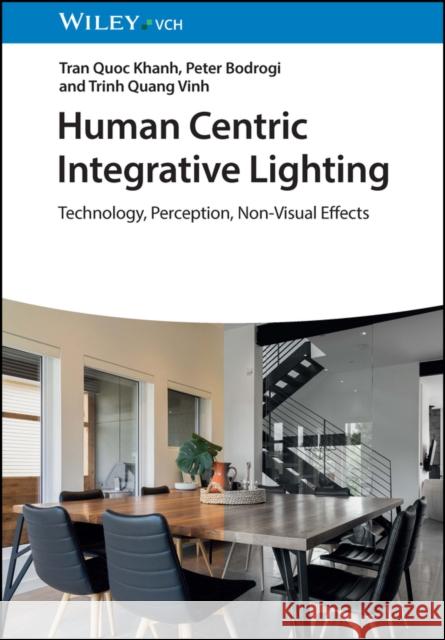Human Centric Integrative Lighting: Technology, Perception, Non-Visual Effects » książka



Human Centric Integrative Lighting: Technology, Perception, Non-Visual Effects
ISBN-13: 9783527414000 / Angielski / Twarda / 2023 / 330 str.
Human Centric Integrative Lighting: Technology, Perception, Non-Visual Effects
ISBN-13: 9783527414000 / Angielski / Twarda / 2023 / 330 str.
(netto: 628,30 VAT: 5%)
Najniższa cena z 30 dni: 652,17 zł
ok. 8-10 dni roboczych
Dostawa przed świętami

Darmowa dostawa!
1. INTRODUCTIONHistory of Lighting EngineeringIlluminating Engineering: Technological Challenges and Relevance to Society Aims and Motivations of the Present Book2. FUNDAMENTALS OF LIGHTING ENGINEERING - VISUAL AND NON-VISUAL ASPECTSThe Human Eye Basic Quantities of Lighting Engineering: V(Lambda) Function, 2° and 10° Colour Matching Functions, Basics of Colorimetry, Colour Spaces, Colour Appearance Models, Colour Rendition Indices, Colour GamutNon-Visual Aspects: CIE 2015, DIN Spec 5031-100, Spectral Sensitivity Functions for Melanopsin, Melatonin Suppression According to Brainard and ThapanThe Metrics Amel According to DIN Spec 5031-100Receptor Signals According to CIE 2018Aging of the Human Eye According to DIN 5031-103. CONVENTIONAL INTERIOR LIGHTING PRINCIPLESDesign Recommendations According to CIE and DIN EN 12464Lighting Quality Criteria, Specifications About Cri, Glare, Modelling Index, Homogeneity, Luminous Efficacy, Shifts of White Point, Illuminance, Luminance4. HCL PRINCIPLES FOR INTERIOR LIGHTINGWhat Is HCL: Definition with Three Components (Visual Performance, Psychological-Emotional Aspects and Non-Visual Aspects)Visual and Non-Visual MechanismsInput and Output Parameters of the HCL SystemInfluencing Factors of the Effect of Light on Humans (Time of the Day, Time of the Year, Weather, Age, Gender) from the Lighting Engineer's Point of View5. VISUAL PERFORMANCEVisual Performance with the V(Lambda) Function: Relative Visual Performance (RVP) Model, Luminance Contrast, Reaction Time, Effect of AgeModern Aspects of Brightness and Visual Clarity: New Experiments About Brightness and Visual Clarity, Models of Brightness and Visual Clarity, Comparison of Brightness Models6. COLOUR QUALITY AND EMOTIONAL ASPECTSColour Quality: Colour Quality and Chroma Enhancement, Visual Experiments in a Viewing Booth and in a Real Room, Modelling of Colour Quality, Modelling of Colour Quality According to Luo, Houser, Wei, Royer, Effect of Red OversaturationPreferred White PointsPreferred Correlated Colour TemperaturesPreferred Ranges of Colour Temperature and Illuminance7. CORRELATION ANALYSIS OF THE NUMERIC METRICS OF HCLMathematical Analysis of the Correlations Between the Three Groups of Metrics: Visual Performance, Colour Quality Metrics and the Descriptors of Non-Visual Effectsthe Um Numeric Method (Um1-Um2) Characterizing the Usefulness of Light SourcesCorrelation Between Brightness Metrics and Cs 8. NEW MODELS OF LIGHTING QUALITY FOR VISUAL AND NON-VISUAL EFFECTSNew Models of Lighting Quality of the Tu Darmstadt 2019 Predicting Visual Clarity, Colour Preference and Scene Preference from Illuminance Level, Correlated Colour Temperature, Circadian Stimulus and A Measure of Object Chroma Enhancement 9. CAUSE-EFFECT RELATIONSHIPS IN HUMAN CENTRIC LIGHTINGEvaluation of HCL Literature from 1990 Until TodayAnalysis and Summary of Field Studies About HCL in Offices, Schools, Hospitals, Industrial Lighting and the Practice of Light TherapyIdentification of Relevant Cause-Effect RelationshipsRecommendations for Practical Lighting Engineering Design10. PRACTICAL LIGHT MEASUREMENT METHODS FOR HCL APPLICATIONS Computational Method for the Value of the Circadian Stimulus (Cs) from Conventional Illuminance, Tristimulus and Correlated Colour Temperature MeasurementsPersonal Dosimetry: Measurement of Cs with ColorimetersSpatially Resolved Light Measurements in Interior Space 11. DAYLIGHTExterior Measurements - Spectral Distribution of Radiation As A Function of Time of the Day and Time of the YearDynamics, Colorimetric and Circadian CharacteristicsEffect of Daylight on Sleeping Quality, Alertness and Vitality Detection and Reconstruction of DaylightDaylight Compensation in Interior Space in Case of Different Weather ConditionsStudies Investigating the Effect of the Possibility of Seeing Exterior Space Through Windows12. HCL TECHNOLOGY IN BUILDINGS Full Spectrum and Sunlight Spectrum: A Spectral AnalysisSpectral Optimisation for Best Colour Quality and Optimum Total HCL EffectSmart Lighting, ConnectivityPrinciples of Data Semantics to Process Different Formats to Achieve A Unique Computational Method in Cloud Servers Network Architecture to Integrate Luminaire Systems with Other Building SystemsBuilding Sensor Technology: Co2 Sensors, Light and Colour Sensors, Motion Sensors, Ir Sensor Array, Weather DataUser Preference of Temperature and Air Quality in Interior SpacesDynamic Light and Lighting Control in Buildings13. SUMMARY AND OUTLOOK
Tran Quoc Khanh is University Professor and Head of the Laboratory of Adaptive Lighting Systems and Visual Processing at TU Darmstadt in Darmstadt, Germany. He received his Ph.D. in Lighting Engineering from the TU Ilmenau, Germany. He received his Degree of Lecture Qualification (Habilitation) from the same university for his in colorimetry and color image processing. He gained industrial experience as a project manager at ARRI CineTechnik in München (Germany). Tran Quoc Khanh has authored and co-authored numerous scientific publications and invented several patents in various fields of lighting technology.Peter Bodrogi was a Senior Research Fellow at the Laboratory of Adaptive Lighting Systems and Visual Processing at the TU Darmstadt in Darmstadt, Germany. He now works for the ERCO GmbH in Lüschenscheid, Germany, in the field of lighting engineering. He received his Ph.D. in Information Technology. He obtained his postdoctoral qualification at the TU Darmstadt for his thesis on the optimization of modern visual technologies. He is co-author of numerous scientific publications and holds patents in the field of self-luminous display technology and lighting technology.Trinh Quang Vinh is a Senior Research Fellow at the Laboratory of Adaptive Lighting Systems and Visual Processing at TU Darmstadt in Darmstadt, Germany. He received his M.Sc. degree in control engineering. He obtained his Dr.-Ing. degree from TU Darmstadt in 2013. His research topic is the complex mathematical modeling of high-power (phosphor-converted) LEDs, including their electrical, thermal, and optical behavior, as well as their light and color quality. He is co-author of several scientific publications and holds patents in the field of LED lighting technology.
1997-2024 DolnySlask.com Agencja Internetowa
KrainaKsiazek.PL - Księgarnia Internetowa









